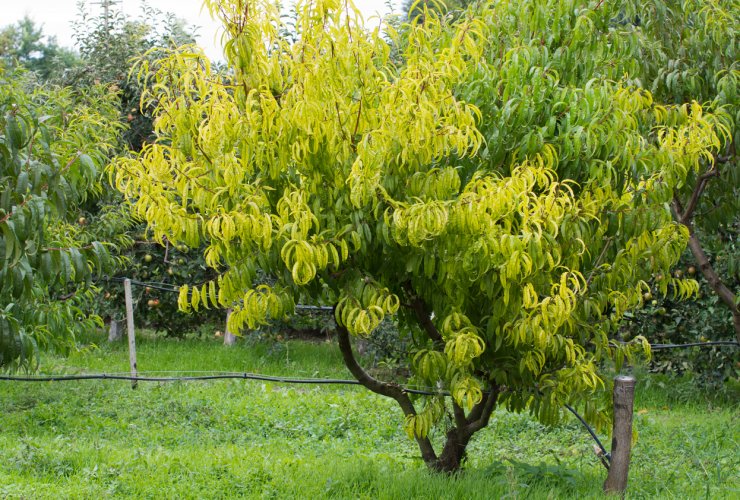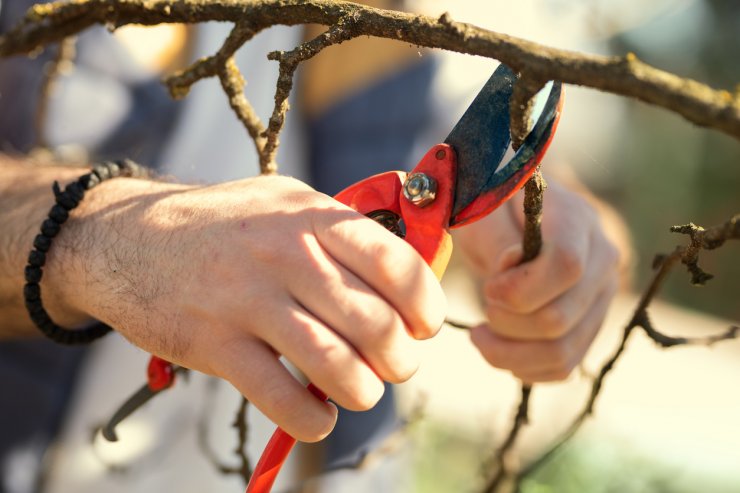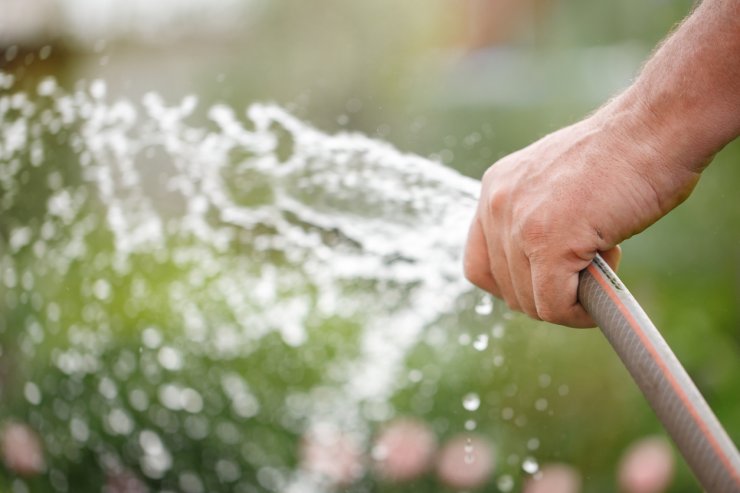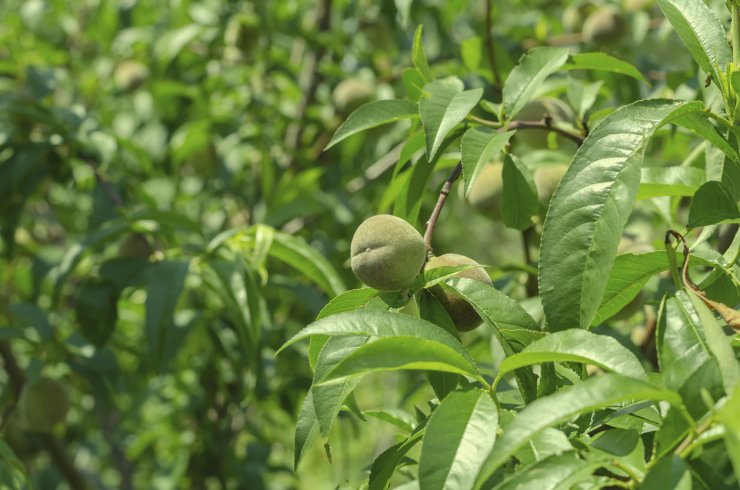
Young peach tree with watering system
Even though you may have to wait a year or two to get a crop, peach trees still require care to get them to that point—and even beyond, to keep them fruiting for you regularly. Here’s the one necessary peach-growing task that many gardeners think about skipping: Pruning the trees.
Plan for Pruning

Pruning a peach tree
Don’t be too worried about pruning. Some gardeners take it far more seriously than others, and both types of gardeners can get healthy peach crops. Understand the basics and you’ll go a long way to getting this chore done properly and with minimal stress. But peach pruning is essential, more than it is for other fruit trees, so don’t skip it entirely.
First, the basic goal of pruning a peach tree is to create an open-centered space, like a vase or bowl, in order to allow for air flow and sunlight to reach all the flowers and fruit. Once you can picture that, pruning is much easier to master.
Pruning peach trees should be done in April, before the tree breaks dormancy and before flowers start to bloom. All pruning starts by taking out dead, broken, or dying branches first, and then removing branches that cross others. Just doing that will reduce congestion and open up the tree.
In the first year, start creating that vase shape by selecting three to four evenly-spaced lateral branches, about 4 to 8 inches apart around the trunk and growing in different directions. These are the main “scaffold” branches.
The best branches to keep will be about as thick as a pencil and no more than 18 inches long—longer stems can be cut back to an upward-facing bud. Now, cut off all other small branches. Remove any excess laterals, too.
In the second year, cut back the branches in the middle of the tree to short stubs and prune any shoots developing below the three or four main branches. At the same time, shorten those scaffolds by one-third to one-half to encourage sub-lateral branching; cut all other small branches back to four or five buds.
Fruit only grows on second-year growth, so what you’re doing each season is setting up the tree to have growth next year that’s got good air flow and access to sunlight. Again, if you picture this, it makes the whole pruning process easier.
During the summer you can lightly prune off fast-growing, vertical shoots that are shading fruit-bearing branches, and any shoots that come from the roots at the base of the tree.
After the third year, remove any shoots in the center of the tree to keep its shape.
And that’s it! If you have more concerns about pruning peach trees, consult your local extension service or garden center for hands-on instruction.
Fertilizing your peach trees

Fertilize your peach trees after their initial fertilization between spring and mid-summer.
Fertilizing peach trees after their first year is different from that initial feeding. First and most important: Fertilizer should only be applied between spring and mid-summer. If you fertilize within two months of the first fall frost date, your tree will be less hardy for the coming winter season.
After the initial fertilization in the first year, give your tree 3/4 to 1 pound of nitrogen or 10-10-10 fertilizer around the tree. Then add another pound of fertilizer each year thereafter, up to 10 pounds for mature standard trees.
Watering your peach trees

Water your peach trees weekly during their first year.
Water peach trees at least weekly during the first year in the ground. Established trees need a regular supply of water throughout any growing season, but keep in mind you’ll get the most succulent, juicy fruit by keeping the soil evenly moist, not excessively wet.
Thinning the fruit

Removing smaller peaches on a peach tree for a larger crop.
As hard as it might seem to bring yourself to do it, you’re going to have to dispose of a lot of fruit. You want to channel the tree’s energy into growing a modest number of good-sized fruits, rather than hundreds of tiny ones. It’s critical for a good crop to thin fruit early.
In fact, you’ll find yourself removing fruit the first time it grows—all of it, in fact. That’s right: Do not allow young peach trees to set fruit during the first two growing seasons. The trees need the energy for growing a strong root system, so remove flowers or young fruit those first two seasons.
During the third year, allow the tree to bear a small crop. Don’t let a tree set more fruit than its limbs can bear.
But once you’re into the third season, you still need to thin the fruit. This is designed to improve the size of your peaches: Never let a peach tree ripen all of the fruit that it sets or you’ll wind up with all-pit, no-flesh peaches.
Thin fruits after what is called the “June drop” when the tree does its own thinning naturally, and when they reach thumbnail size, about one inch in diameter. Thin from 6 to 8 inches apart.
Thin peaches again while the fruit is still green—usually in early summer. Thin fruits from 4 to 5 inches apart. This will allow the remaining fruit to grow large and sweet: Thinning increases the sugar content and flavor of the remaining fruit.
What are your techniques for pruning, fertilizing, watering, and thinning your peach crop? Do you have any special “tricks” to keep your peaches healthy from the start and throughout the season? Please tell us your best practices for peach farming.


 Previous
Previous

